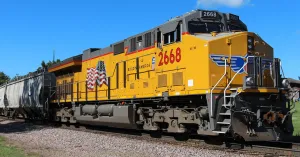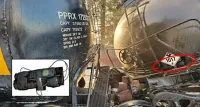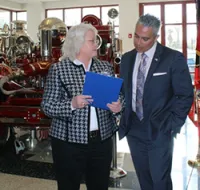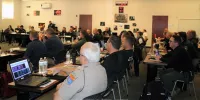 Union Pacific train (Union Pacific photo)
Union Pacific train (Union Pacific photo)
Imagine a freight train derails and emergency responders rush to the scene, only to find the derailment worse than they thought.
They discover an improvised explosive device (IED) on one of the derailed tank cars that was spewing toxic chemicals.
Fortunately, this was just a training exercise.
The TSA Phoenix surface field office hosted the exercise for Union Pacific, the largest railroad in North America, covering 23 states across the western two-thirds of the U.S.
Region 5 Regional Security Inspector Mike Madrigal said the exercise brought dozens of people from numerous private, local, state and federal agencies to the table.
“More than 70 people attended the exercise, representing Union Pacific, adjacent pipeline companies, local/state/tribal police and fire departments, private stakeholders and a partner railroad from Mexico,” said Madrigal.
Representatives from the Department of Homeland Security Cybersecurity and Infrastructure Security Agency, Customs and Border Protection, the FBI, Amtrak, Southwest Gas, and Kinder Morgan participated along with several other companies and agencies from all over Arizona and parts of California.
In the exercise, someone called a bomb threat into the Union Pacific Response Management Communications Center in Omaha, Nebraska. Then, a suspicious bag was supposedly found at the Amtrak station in Tucson, Arizona, followed by a train derailment and the discovery of an IED in one of the derailed cars.
Tucson TSA Inspector Sharon Mathews, who, along with Madrigal, facilitated the training, said bomb threats are real on our nation’s railways.
“Suspicious bags and suspicious items are found daily within the freight rail and mass transit environment,” said Mathews. “This is why the exercise was so important. It allowed agencies and first responders to talk through the response and handling process in the safety and comfort of a classroom.”
The training was part of TSA’s Exercise Information System, also known as EXIS®, which provides transportation system owners and operators with resources to design, document and evaluate exercises to further enhance their security.
“The exercise was important because it brought together several different agencies with varying levels of training and experience,” Madrigal assessed. “These exercises enable organizations to assess the effectiveness of their plans, facilitate teamwork and collaboration, and train personnel in a simulated environment.”
Mathews said collaboration and networking are essential in the world of security, and information sharing and partnerships help connect the dots.
“To effectively protect and enhance our nation’s security, we must work together,” stressed Mathews. “TSA desires to be proactive in preventing security incidents and increasing security awareness. TSA’s Surface Operations is increasing the public’s trust and partnership with local industry. We also see this as an opportunity to use our tools to increase public safety.”
Mathews said the exercise helped identify gaps in emergency communication procedures and employee training and allowed participants to learn about each agency’s resources and capabilities.
“Knowledge gained from the exercise can be used to improve communication between emergency responders and neighboring properties; establish communication procedures; improve employee training; and establish new relationships with state, local and federal emergency response organizations,” she noted.
Mathews said the exercise was a success with very positive responses from participants.
“The attendees showed interest in more of these types of exercises,” she said. “This kind of training for the public lets people know about our programs, which increases our standing with communities across the country.”
By Don Wagner, TSA Strategic Communications & Public Affairs



